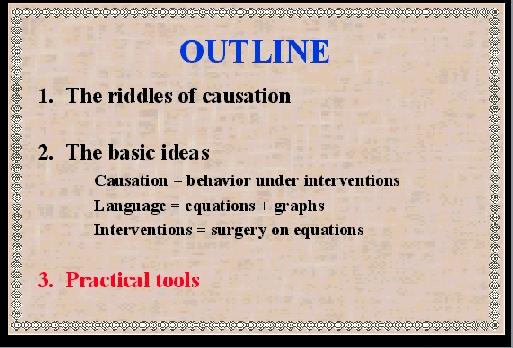
|
SLIDE 58: OUTLINE
Things brings us to part-3 of the lecture,
where I will demonstrate how the ideas presented
thus far can be used to solve new problems of
practical importance.
|
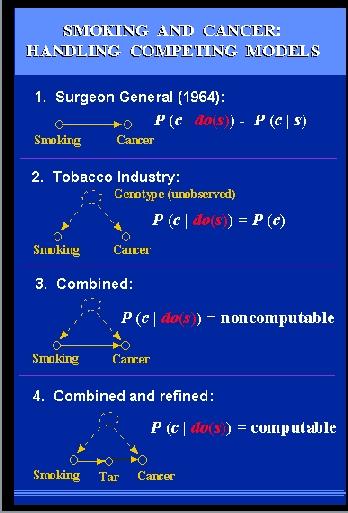
|
SLIDE 59: DOES SMOKING CAUSE CANCER
Consider the century old debate concerning the
effect of smoking on lung cancer.
In 1964, the Surgeon General issued a report linking
cigarette smoking to death, cancer and most particularly,
lung cancer.
The report was based on non-experimental studies, in which
a strong correlation was found between smoking and lung
cancer, and the claim was that the correlation found is
causal, namely:
If we ban smoking, the rate of
cancer cases will be roughly the same
as the one we find today among non-smokers in the population.
These studies came under severe attacks from
the tobacco industry, backed by some very prominent statisticians,
among them Sir Ronald Fisher.
The claim was that the observed correlations can
also be explained by a model in which there is no causal connection
between smoking and lung cancer.
Instead, an unobserved
genotype might exist which simultaneously
|
causes cancer and
produces an inborn craving for nicotine.
Formally, this claim would be written in our notation
as: P(cancer | do(smoke)) = P(cancer)
stating that making the population smoke or stop smoking
would have no effect on the rate of cancer cases.
Controlled experiment could decide between the two models, but
these are impossible, and now also illegal to conduct.
This is all history.
Now we enter a hypothetical
era where representatives of both sides decide
to meet and iron out their differences.
The tobacco industry concedes that there might
be some weak causal link between smoking and
cancer and representatives of the health group
concede that there might be some weak links to
genetic factors.
Accordingly, they draw this combined model,
and the question boils down to assessing,
from the data, the strengths of the various links.
They submit the query to a statistician and the answer
comes back immediately: IMPOSSIBLE.
Meaning: there is
no way to estimate the strength from the data, because
any data whatsoever can perfectly fit either
one of these two extreme models.
So they give up, and decide to continue the political
battle as usual.
Before parting, a suggestion comes up:
perhaps we can resolve our differences,
if we measure some auxiliary factors,
For example, since the causal link model
is based on the understanding that smoking affects
lung cancer through the accumulation of tar deposits
in the lungs, perhaps we can measure the amount of
tar deposits in the lungs of sampled individuals, and this might provide
the necessary information for quantifying the links?
Both sides agree that this is a reasonable suggestion,
so they submit a new query to the statistician: Can we
find the effect of smoking on cancer assuming that an
intermediate measurement of tar deposits is available???
The statistician comes back with good news: IT IS COMPUTABLE and,
moreover, the solution is given in close mathematical form. HOW?
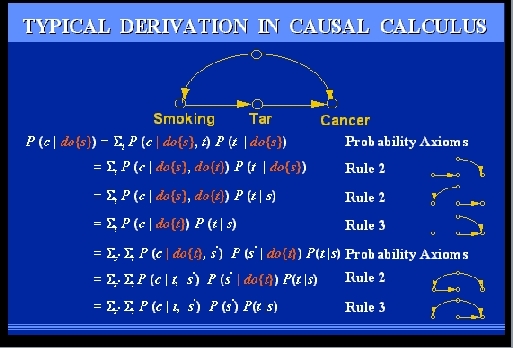
|
SLIDE 60: TYPICAL DERIVATION IN CAUSAL CALCULUS
The statistician receives the problem, and treats it as
a problem in High School ALGEBRA: We need to compute P(cancer) under
hypothetical action, from non-experimental data, namely,
from expressions involving NO ACTIONS. Or: we need to
eliminate the "do" symbol from the initial expression.
The elimination proceeds like ordinary solution of algebraic
equation - in each stage, a new rule is applied, licensed by some subgraph
of the diagram, until eventually leading to a formula involving only
WHITE SYMBOLS, meaning expression computable from non-experimental data.
You are probably wondering whether this derivation
solves the smoking-cancer debate. The answer is NO.
Even if we could get the data on tar deposits, the
model above is
|
quite simplistic, as it is based on certain
assumptions which both parties might not agree to.
For instance,
that there is no direct link between smoking and lung cancer,
immediated by tar deposits.
The model would need to be refined then, and we might
end up with a graph containing 20 variables or more.
There is no need to
panic when someone tells
us: "you did not take this or that factor into account".
On the contrary, the graph welcomes such new
ideas, because it is so easy to add factors and measurements
into the model.
Simple tests are now available that permit an investigator to merely
glance at the graph and decide if we can compute the effect of one variable
on another.
Our next example illustrates how a long-standing problem is solved
by purely graphical means - proven by the new algebra.
The problem is called THE ADJUSTMENT PROBLEM or "the covariate selection
problem" and represents the practical side of Simpson's paradox.
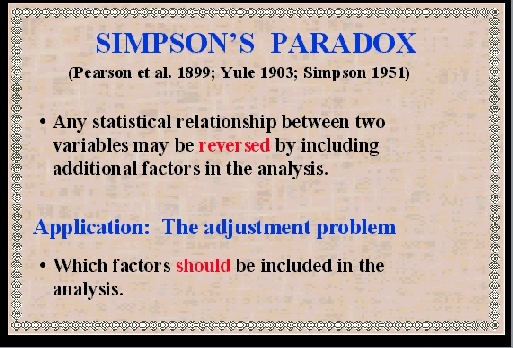
|
SLIDE 61: SIMPSON'S PARADOX
Simpson's paradox, first noticed by Karl Pearson in 1899, concerns
the disturbing observation that every statistical relationship between
two variables may be REVERSED by including additional factors
in the analysis.
For example, you might run a study and find that students who smoke
get higher grades, however, if you adjust for AGE, the opposite is true in every AGE GROUP, namely, smoking predicts lower grades.
If you further adjust for PARENT INCOME, you find that smoking predicts
higher grades again, in every AGE-INCOME group, and so on.
Equally disturbing is the fact that no one has been able to tell
us which factors SHOULD be included in the analysis.
Such factors can now be identified by simple graphical means.
|
The classical case demonstrating Simpson's paradox
took place in 1975, when UC Berkeley was investigated for
sex bias in graduate admission.
In this study,
overall data showed a higher rate of admission among male
applicants, but, broken down by departments, data showed a
slight bias in favor of admitting female applicants.
The explanation is simple: female applicants tended
to apply to more competitive departments than males,
and in these departments, the rate of admission was low for
both males and females.

|
SLIDE 62: FISHNET
To illustrate this point, imagine a fishing boat with two
different nets, a large mesh and a small net. A school of fish swim towards
the boat and seek to pass it.
The female fish try for the small-mesh challenge, while the male
fish try for the easy route. The males go through and only females are caught.
Judging by the final catch, preference toward female is clearly
evident. However, if analyzed separately, each individual net would
surely trap males more easily than females.
Another example involves a controversy
called "reverse regression", which occupied the social
science literature in the 1970's.
Should we, in salary discrimination
cases, compare salaries of equally qualified men and women,
or, instead, compare qualifications of equally paid men
and women?
Remarkably, the two choices led to
|
opposite conclusions.
It turned out that men earned
a higher salary than equally qualified women,
and SIMULTANEOUSLY, men were more qualified than
equally paid women.
The moral is that all conclusions are extremely
sensitive to which variables we choose to hold constant
when we are comparing, and that is why the adjustment problem
is so critical in the analysis of observational studies.
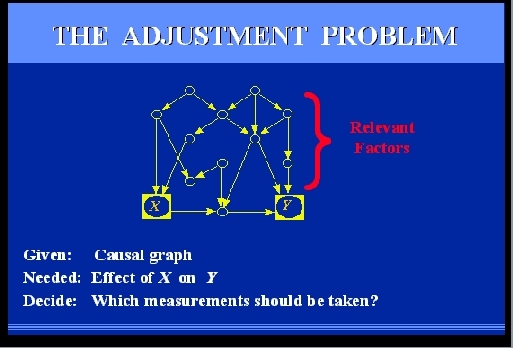
|
SLIDE 63: THE STATISTICAL ADJUSTMENT PROBLEM
Consider an observational study where we wish to
find the effect of X on Y, for example, treatment on
response.
We can think of many factors that are relevant to the problem;
some are affected by the treatment, some
are affecting the treatment and some are affecting
both treatment and response.
Some of these factors may be unmeasurable, such
as genetic trait or life style, others are measurable,
such as gender, age, and salary level.
Our problem is to select a subset of these factors
for measurement and adjustment, namely, that if we compare subjects
under the same value of those measurements and average, we get the
right result.
|
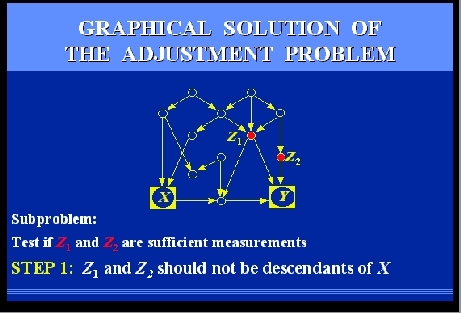
|
SLIDE 64: GRAPHICAL SOLUTION OF THE ADJUSTMENT PROBLEM
Let us follow together the steps that would be required to
test if two candidate measurements, Z1
and Z2, would be sufficient.
The steps are rather simple, and can be performed manually, even on
large graphs.
However, to give you the feel of their mechanizability, I
will go through them rather quickly.
Here we go.
|
SLIDES 65-69: GRAPHICAL SOLUTION OF THE ADJUSTMENT PROBLEM (CONT)
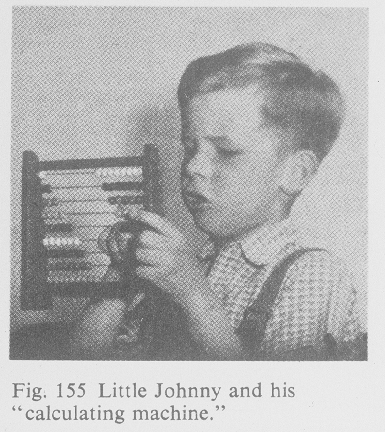
|
SLIDE 70: ABACUS
What I have presented to you today is a sort of pocket
calculator, an ABACUS, to help us investigate certain
problems of cause and effect with mathematical precision.
This does not solve all the problems of causality, but
the power of SYMBOLS and mathematics
should not be underestimated.
|
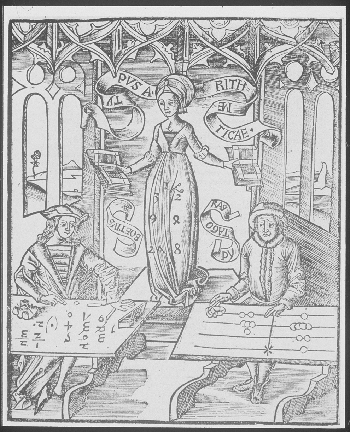
|
SLIDE 71: A CONTEST BETWEEN THE OLD AND THE NEW ARITHMETIC
Many scientific discoveries have been
delayed over the centuries for the lack
of a mathematical language that can amplify ideas and
let scientists communicate results.
And I am convinced that many discoveries have been delayed
in our century for lack of a mathematical language that can
handle causation.
For example, I am sure that Karl Pearson could have thought up the
idea of RANDOMIZED EXPERIMENT in 1901,
if he had allowed causal diagrams into his mathematics.
But the really challenging problems are still ahead:
We still do not have a causal understanding of POVERTY and
CANCER and INTOLERANCE,
and only the accumulation of data and the insight of
great minds will eventually lead to such understanding.
The data is all over the place, the insight is yours,
and now an abacus is at your disposal too.
I hope the combination amplifies each of these components.
Thank you.
|
Remarks: technical details can be found in
J. Pearl, "The new challenge: From a century of statistics to an age of
causation." Presented at the IASC Second World Congress, Pasadena, CA,
February 1997.
J. Pearl, "Causal diagrams for experimental research," (with discussion),
Biometrika, 82(4), 669-710, December 1995,
J. Pearl, "Structural and probabilistic causality,'' In D.R. Shanks,
K.J. Holyoak, and D.L. Medin (Eds.), The Psychology of Learning and
Motivation, Vol. 34 Academic Press, San Diego, CA, 393-435, 1996.
Hard copies of these and other related publications can be
obtained from
Prof. Judea Pearl
UCLA Computer Science Department
4532 Boelter Hall
Los Angeles, CA 90095-1596
or download a postscript file from
http://singapore.cs.ucla.edu/frl_papers.html.

